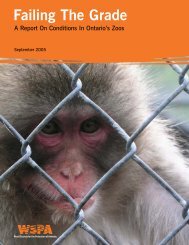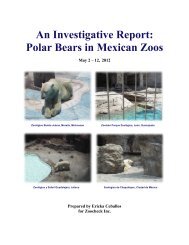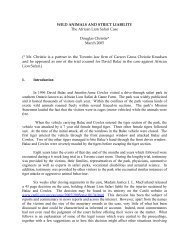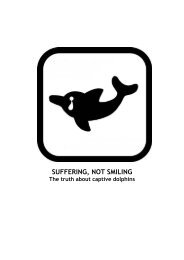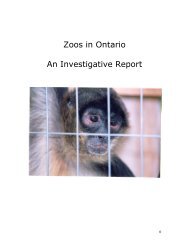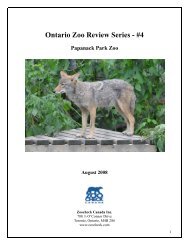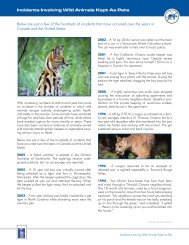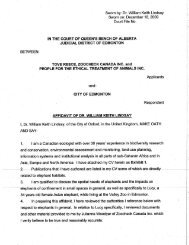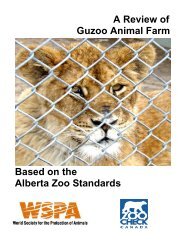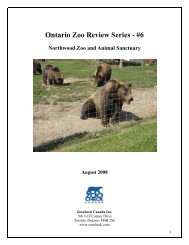STATUS OF BEAR WELFARE
STATUS OF BEAR WELFARE
STATUS OF BEAR WELFARE
You also want an ePaper? Increase the reach of your titles
YUMPU automatically turns print PDFs into web optimized ePapers that Google loves.
Status of Bear Welfare in Cherokee, North Carolina<br />
arthritis. Calluses also tend to crack when they are exposed to abrasive surfaces. Cracks in the<br />
footpads are very painful and prone to infection. The source of infection can be standing water,<br />
feces, urine, or decomposing foodstuffs. Foot wounds that become contaminated by<br />
environmental pathogens are extremely difficult to treat, as healing is delayed by constant use of<br />
the feet as well as the bacteria’s level of antibiotic resistance. Besides being a source of constant<br />
pain, sore feet further limit mobility in bears who already do not get sufficient exercise. Decreased<br />
mobility contributes to obesity, which leads to increased weight supported by the feet, which<br />
worsens pre-existing foot problems.<br />
In cases in which calluses have not had time to develop or animals demonstrate stereotypic<br />
behaviors such as pacing on concrete floors, footpads are subject to thinning and the formation of<br />
blisters and ulcers. 12 Exposed soft tissue and unprotected nerve endings can result in secondary<br />
infection or extremely painful sores that heal poorly or re-flare because of constant weightbearing.<br />
Feet<br />
The main function of the foot is to act as a shock absorber as weight is shifted with every step.<br />
The flexible sole also allows contact with the various irregularities of a natural environment; this<br />
keeps the muscles and tendons of the feet and legs properly toned, drives blood in the<br />
extremities back to the heart, and provides tactile feedback to the bear regarding his or her<br />
environment.<br />
The foot is designed to adapt to a variety of surfaces, from soft to hard; however, periods of<br />
protracted weight-bearing on flat, hard surfaces such as concrete can give rise to serious foot,<br />
joint, muscle, and circulatory problems. Humans have commonly regarded excessive standing or<br />
walking on concrete as a workplace safety hazard for their own species.<br />
Overuse of the feet was evidenced by the worn claws and the paths that the bears had worn into<br />
the concrete around the pit doors.<br />
Footpads<br />
Footpad trauma from constant contact with hard, abrasive concrete was evident in some of the<br />
bears observed. Being in constant contact with concrete flooring, the footpads of the bears were<br />
subject to the potential for thermal, chemical, and/or mechanical trauma.<br />
Photo 9A taken at CBZ shows wear points in the center of each toe pad. This is the weightbearing<br />
area on the footpad. Forefeet take the brunt of the wear and tear, as 60 percent of the<br />
body’s weight is carried forward, and this is exacerbated with obesity. And when bears become<br />
arthritic, they will shift even more weight forward in effort to relieve hip pain.<br />
Photo 9B of a bear in the Marge/Elvis pit at CBZ shows what appears to be a deep crack and<br />
wear point on the right front paw, central footpad. Most of the toe pads have central wear points.<br />
The light spots are areas where the pad leather has worn down to softer, more sensitive tissue,<br />
and this foot would be tender to walk on. With further wear, these areas could develop ulcers.<br />
Pad cracks are very painful (like heel cracks in humans).<br />
AN INVESTIGATIVE REPORT <strong>OF</strong> CHIEF SAUNOOKE <strong>BEAR</strong> PARK, CHEROKEE <strong>BEAR</strong> ZOO, AND SANTA’S LAND | 31





